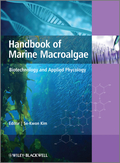
The Handbook of Macroalgae: Biotechnology and Applied Phycology describes thebiological, biotechnological and the industrial applications of seaweeds. Vast research into the cultivation of seaweeds is currently being undertaken but there is a lack of methodological strategies in place to develop novel drugs from these sources. This book aims to rectify this situation, providing an important review of recent advances and potential new applications for macroalgae.Focusing on the chemical and structural nature of seaweeds the book brings the potentially valuable bioactive nature to the fore. Novel compounds isolated from seaweeds are reviewed to provide an invaluable reference for anyone working in the field. INDICE: List of Contributors Preface Editor PART I Introduction to Algae and Their Importance 1 Biological Importance of Marine Algae Ali A. El Gamal 1.1 Introduction 1.2 Interesting natural products and their biological activities from macroalgae (seaweeds) 1.2.1 Chlorophyta (green algae) 1.2.2 Phaeophyta (brown algae) 1.2.3 Rhodophyta (red algae) Acknowledgment References 2 Seaweeds: The Wealth of Oceans Upadhyayula Suryanarayana Murty and Amit Kumar Banerjee 2.1 Introduction 2.2 Need for marine resources 2.3 Various marine resources 2.4 Producers in the marine environment 2.5 Emergent plants 2.6 Seaweed diversity 2.7 Uses of seaweeds 2.8 Marine farming: global scenario 2.9 SEAPURA: an EU effort 2.10 Seaweed farming: an Indian scenario 2.11 Expanding the existing knowledge base: current research trends in exploring seaweeds 2.11.1 Metagenomics in understanding seaweeds 2.11.2 Role of bioinformatics 2.11.3 Data storage and retrieval 2.11.4 Different kind of information analysis 2.11.5 Phylogeographical and evolutionary analysis 2.12 Future prospects 2.13 Conclusion References vi CONTENTS 3 Eco-Biochemical Studies of Common Seaweeds in the Lower Gangetic Delta Rajrupa Ghosh, Kakoli Banerjee and Abhijit Mitra 3.1 Seaweeds: anoverview 3.2 Commercial uses of seaweeds 3.3 Indian scenario 3.4 Biochemical composition of seaweeds with special reference to Indian Sundarbans References4 Chemodiversity and Bioactivity within Red and Brown Macroalgae Along the French coasts, Metropole and Overseas Departements and Territories Nathalie Bourgougnon and Valerie Stiger-Pouvreau 4.1 Introduction 4.2 Exploitation of marine algal resources 4.2.1 International context 4.2.2 French and Breton context 4.3.3 French research network on marine bioactive compounds extracted from macroalgae 4.3 Why a focus on red and brown seaweeds? 4.4 Marine red seaweeds andbiological activities 4.4.1 Polysaccharides 4.4.2 Phycoerythrin 4.5 Marine brown seaweeds and biological activities 4.5.1 Polysaccharides 4.5.2 Phenolic compounds (phloroglucinol and derived products) 4.5.3 Terpenes 4.6 The use of metabolites from marine red and brown algae for their chemical defense 4.6.1 Biotic interactions of marine red and brown algae (pathogens, grazing, etc.) 4.6.2 Biofouling 4.7 The use of metabolites as chemomarkers for taxonomy 4.8 Industrial uses of metabolites from marine red and brown algae 4.8.1 Algae for nutritional foods 4.8.2 Algae for health and cosmetics 4.8.3 Algae against microorganisms 4.10 Conclusion Acknowledgments References 5 Physiological Basis for the use of Seaweeds as Indicators of Anthropogenic Pressures: The Case of GreenTides Jesus M. Mercado 5.1 Introduction 5.2 Light absorption 5.3 Photosynthesis at sub- and saturating irradiance 5.4 Inorganic carbon acquisition 5.5 Doesthe high capacity for using bicarbonate favor the development of green tides?5.6 Conclusions Acknowledgments References 6 Significance of the Presence of Trace and Ultratrace Elements in Seaweeds Antonio Moreda-Pi"neiro, Elena Pe"na-V'azquez and Pilar Bermejo-Barrera 6.1 Introduction 6.2 Mineral content in seaweed 6.3 Trace and ultratrace elements in seaweeds 6.3.1 Legislation concerning seaweed consumption 6.3.2 Trace and ultratrace elements in seaweed: studiesconcerning seaweed edibility 6.3.3 Radionuclides in edible seaweed 6.4 Trace and ultratrace elements in seaweed: pollution biomonitoring 6.4.1 Seaweeds as bioindicators 6.4.2 Trace and ultratrace elements in seaweed: studies concerning environmental monitoring. Etc.
- ISBN: 978-0-470-97918-1
- Editorial: John Wiley & Sons
- Encuadernacion: Cartoné
- Páginas: 567
- Fecha Publicación: 30/11/2011
- Nº Volúmenes: 1
- Idioma: Inglés
